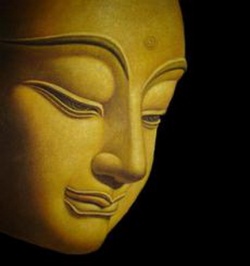Difference between revisions of "Sutta Nipata"
| Line 4: | Line 4: | ||
The [[Sutta Nipàta]] is a [[book]] in the [[Khuddaka Nikaya]], the fifth part of the [[Sutta Pitaka]], the first division of the [[Tipitaka]], the [[sacred]] [[scriptures]] of [[Buddhism]]. | The [[Sutta Nipàta]] is a [[book]] in the [[Khuddaka Nikaya]], the fifth part of the [[Sutta Pitaka]], the first division of the [[Tipitaka]], the [[sacred]] [[scriptures]] of [[Buddhism]]. | ||
| − | The [[name]] [[Sutta Nipàta]] means ‘[[collection of discourses]]’ and the work contains fifty-five discourses of 1149 verses altogether. The [[Sutta Nipàta]] contains some of the most lyrical and evocative [[poetry]] in the [[scriptures]], much of it drawing on the [[imagery]] of the natural enviroment. For example, a [[monk]] is urged to give up [[clinging]] ‘the way a {{Wiki|snake}} outgrows its worn out {{Wiki|skin}}’ and to ‘be alone like a rhinoceros.’ | + | The [[name]] [[Sutta Nipàta]] means ‘[[collection of discourses]]’ and the work contains fifty-five [[discourses]] of 1149 verses altogether. The [[Sutta Nipàta]] contains some of the most lyrical and evocative [[poetry]] in the [[scriptures]], much of it drawing on the [[imagery]] of the natural enviroment. For example, a [[monk]] is urged to give up [[clinging]] ‘the way a {{Wiki|snake}} outgrows its worn out {{Wiki|skin}}’ and to ‘be alone like a rhinoceros.’ |
All its [[suttas]] consist largely of verse, though some also contain some prose. It is divided into five [[sections]]: | All its [[suttas]] consist largely of verse, though some also contain some prose. It is divided into five [[sections]]: | ||
| Line 19: | Line 19: | ||
* Tr [[Viggo Fausböll|V. Fausbøll]], in ''[[Sacred]] [[Books]] of the [[East]]'', volume X, Clarendon/Oxford, 1881; reprinted by {{Wiki|Motilal Banarsidass}}, {{Wiki|Delhi}} (?and by Dover, {{Wiki|New York}}) | * Tr [[Viggo Fausböll|V. Fausbøll]], in ''[[Sacred]] [[Books]] of the [[East]]'', volume X, Clarendon/Oxford, 1881; reprinted by {{Wiki|Motilal Banarsidass}}, {{Wiki|Delhi}} (?and by Dover, {{Wiki|New York}}) | ||
| − | * ''[[Buddha's Teachings]]'', tr [[Wikipedia:Robert Chalmers, 1st Baron Chalmers|Lord Chalmers]], Harvard {{Wiki|Oriental}} Series, 1932 | + | * ''[[Buddha's Teachings]]'', tr [[Wikipedia:Robert Chalmers, 1st Baron Chalmers|Lord Chalmers]], {{Wiki|Harvard}} {{Wiki|Oriental}} Series, 1932 |
* ''Woven Cadences'', tr E. M. {{Wiki|Hare}}, 1945, out of print | * ''Woven Cadences'', tr E. M. {{Wiki|Hare}}, 1945, out of print | ||
* ''The [[Group of Discourses]]'', tr {{Wiki|K. R. Norman}}, 1984, {{Wiki|Pali Text Society}}[http://www.palitext.com], Bristol; the original edition included alternative translations by I. B. Horner & [[Walpola Rahula]]; these are currently available in the paperback edition under the title ''The Rhinoceros Horn and Other Early [[Buddhist]] Poems''; the current edition under the original title omits these, but includes instead the translator's notes, not included in the paperback | * ''The [[Group of Discourses]]'', tr {{Wiki|K. R. Norman}}, 1984, {{Wiki|Pali Text Society}}[http://www.palitext.com], Bristol; the original edition included alternative translations by I. B. Horner & [[Walpola Rahula]]; these are currently available in the paperback edition under the title ''The Rhinoceros Horn and Other Early [[Buddhist]] Poems''; the current edition under the original title omits these, but includes instead the translator's notes, not included in the paperback | ||
Revision as of 17:37, 1 April 2014
The Sutta Nipata [1] is a Buddhist scripture, a sutta collection in the Khuddaka Nikaya, part of the Pali Canon of Theravada Buddhism.
The Sutta Nipàta is a book in the Khuddaka Nikaya, the fifth part of the Sutta Pitaka, the first division of the Tipitaka, the sacred scriptures of Buddhism.
The name Sutta Nipàta means ‘collection of discourses’ and the work contains fifty-five discourses of 1149 verses altogether. The Sutta Nipàta contains some of the most lyrical and evocative poetry in the scriptures, much of it drawing on the imagery of the natural enviroment. For example, a monk is urged to give up clinging ‘the way a snake outgrows its worn out skin’ and to ‘be alone like a rhinoceros.’
All its suttas consist largely of verse, though some also contain some prose. It is divided into five sections:
Some scholars[2] believe that it describes the oldest of all Buddhist practices. Others agree that it contains much very early material.
Translations
- Tr V. Fausbøll, in Sacred Books of the East, volume X, Clarendon/Oxford, 1881; reprinted by Motilal Banarsidass, Delhi (?and by Dover, New York)
- Buddha's Teachings, tr Lord Chalmers, Harvard Oriental Series, 1932
- Woven Cadences, tr E. M. Hare, 1945, out of print
- The Group of Discourses, tr K. R. Norman, 1984, Pali Text Society[1], Bristol; the original edition included alternative translations by I. B. Horner & Walpola Rahula; these are currently available in the paperback edition under the title The Rhinoceros Horn and Other Early Buddhist Poems; the current edition under the original title omits these, but includes instead the translator's notes, not included in the paperback
- Tr Saddhatissa, Curzon, London/Humanities Press, New York, 1985
- Tr N. A. Jayawickrama, University of Kelaniya, 2001
Footnotes
- ↑ When referencing suttas from the Sutta Nipata the case-sensitive abbreviation "Sn" is used. This is distinguished from the abbreviation "SN" which traditionally refers to the Pali canon's Samyutta Nikaya.
- ↑ Nakamura, Indian Buddhism, Japan, 1980; reprinted by Motilal Banarsidass, Delhi, 1987, 1989, pp. 45-6.
